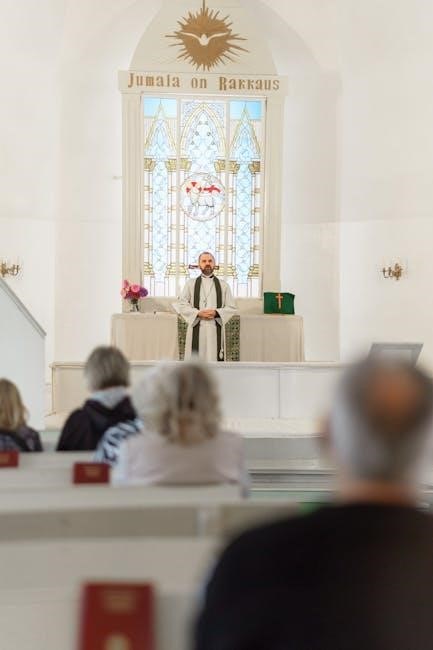The Roman Catholic Funeral Mass Order of Service is a structured liturgy providing a framework for celebrating the Mass with dignity and comfort. It outlines the sequence of prayers, readings, and rituals, ensuring a meaningful and reverent celebration. This order is rooted in the Catholic Church’s tradition, offering comfort to the grieving and hope in eternal life through the resurrection of Jesus Christ.
1.1. Overview of the Funeral Mass Structure
The Roman Catholic Funeral Mass follows a structured order designed to honor the deceased, comfort mourners, and reflect Catholic beliefs about death and eternal life. The Mass is divided into four main sections: Introductory Rites, Liturgy of the Word, Eucharistic Liturgy, and Concluding Rites. Each part serves a specific purpose, from welcoming the congregation to offering prayers for the deceased and celebrating the Eucharist. The structure ensures a balanced blend of prayer, scripture, and sacrament, providing a dignified and meaningful way to farewell the deceased while expressing hope in the resurrection. This order is guided by the Church’s traditions and the Order of Christian Funerals, ensuring consistency and reverence throughout the service.
1.2. Importance of the Order of Service in Catholic Funerals
The Order of Service in a Catholic Funeral Mass is essential for providing structure, comfort, and meaning to the bereaved. It ensures the liturgy is conducted with dignity and reverence, honoring the deceased while reflecting Catholic beliefs about death, resurrection, and eternal life. The order also serves as a guide for participants, helping them engage in the prayers and rituals with understanding and devotion. By following the established sequence, the funeral liturgy remains consistent with Church traditions and teachings, offering solace to mourners through the power of communal prayer and sacraments.
Additionally, the Order of Service underscores the Catholic faith’s emphasis on hope and mercy, reinforcing the belief that the deceased is entrusted to God’s loving care. This structured approach ensures the funeral is both a celebration of the deceased’s life and a profound expression of Christian faith.
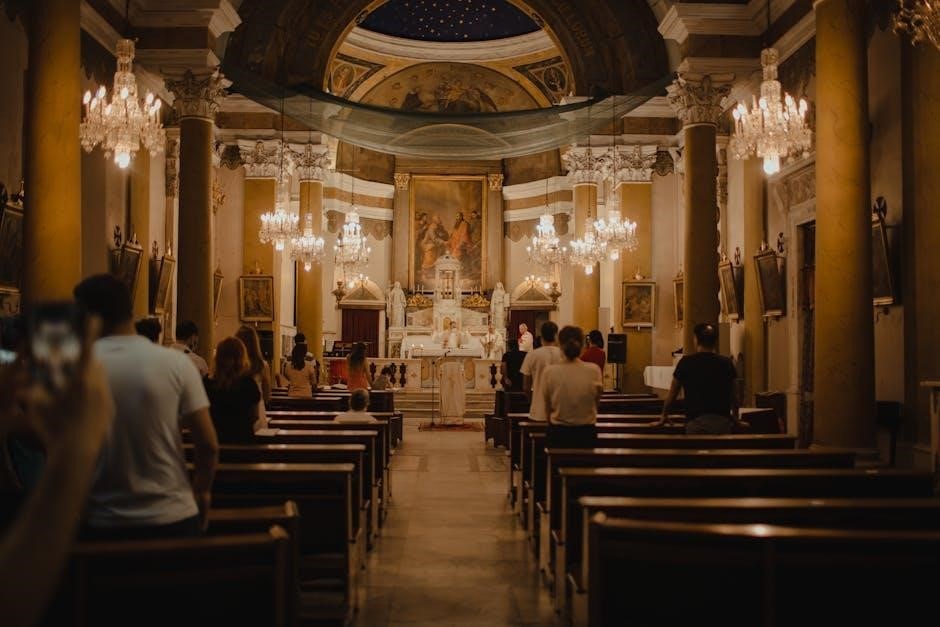
The Introductory Rites
The Introductory Rites initiate the Funeral Mass, comprising the Entrance Procession, Sprinkling of Holy Water, and Opening Prayer. These rituals establish a reverent tone and prepare the congregation for the sacred celebration.
2.1. Entrance Procession and Greeting
The Entrance Procession begins the Funeral Mass, typically led by the priest, altar servers, and pallbearers. The casket or urn is carried into the church, accompanied by the family and congregation. Upon reaching the altar, the priest greets the assembly, invoking God’s mercy and grace. This rite sets a solemn yet hopeful tone, acknowledging the gathering for worship and the commendation of the deceased. The procession symbolizes the community’s unity in faith and their collective prayer for the departed. The greeting serves as an invitation to participate actively in the liturgy, seeking comfort and strength through the Eucharistic celebration.
2.2. Sprinkling of Holy Water
The Sprinkling of Holy Water is a solemn ritual within the Funeral Mass, symbolizing purification and remembrance of baptism. The priest sprinkles holy water upon the casket or urn, invoking prayers for the forgiveness of the deceased’s sins. This act connects the mourners to their baptismal vows and serves as a reminder of the hope of eternal life. The water, blessed by the Church, carries spiritual significance, offering comfort to the grieving and reinforcing the belief in resurrection. This rite is a powerful gesture of faith, uniting the community in prayer and preparation for the liturgy ahead.
2.3. Opening Prayer
The Opening Prayer, also known as the Collect, marks the transition from the introductory rites to the liturgy of the word. The priest leads the assembly in a solemn prayer, invoking God’s mercy and comfort for the mourners. This prayer typically expresses hope in the resurrection and commends the deceased to God’s care. It is a moment of reflection, uniting the congregation in faith and petition. The prayer’s themes of redemption, eternal life, and divine compassion resonate deeply, offering solace to those grieving. The Opening Prayer sets the tone for the Funeral Mass, emphasizing trust in God’s plan and the belief in eternal rest for the departed.
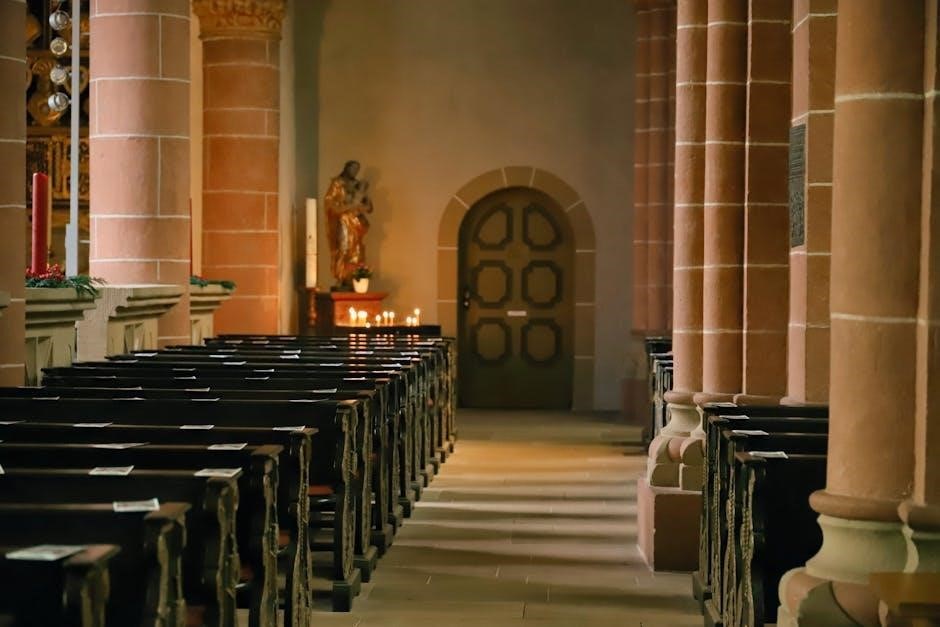
The Liturgy of the Word
The Liturgy of the Word is a central part of the Funeral Mass, featuring the First Reading, Responsorial Psalm, Second Reading, and Gospel. These readings offer comfort and hope through God’s Word.
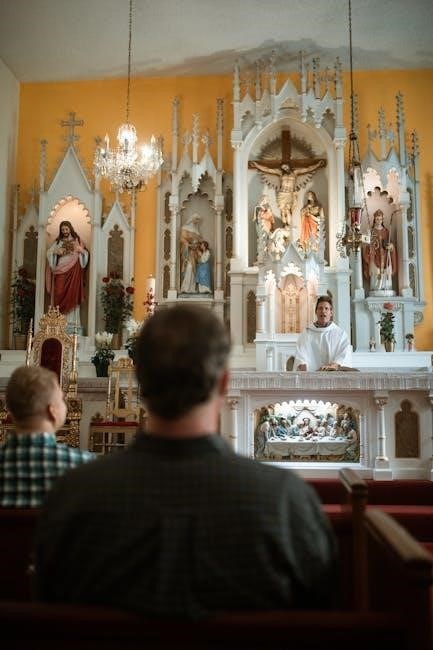
3.1. First Reading (Old Testament)
The First Reading is selected from the Old Testament, offering passages that reflect themes of hope, resurrection, and trust in God. These readings provide comfort and spiritual strength to the mourners. They are chosen from designated books such as Wisdom, Maccabees, or the Prophets, each offering unique insights into God’s plan and the promise of eternal life. The reading is typically proclaimed by a family member or a designated reader, adding a personal touch to the liturgy. The Old Testament reading sets the tone for the Liturgy of the Word, reminding the assembly of God’s faithfulness and the ultimate hope of resurrection. Its message serves as a foundation for the Gospel reading that follows.
3.2. Responsorial Psalm
The Responsorial Psalm is a musical response following the First Reading, led by a cantor or choir, with the congregation joining in the refrain. It is chosen for its comforting themes, such as trust in God and hope in eternal life. The psalm, typically from the Old Testament, reflects on divine mercy and provides solace to mourners. Its rhythmic and lyrical nature creates a participatory atmosphere, allowing the assembly to express faith and find consolation. The Responsorial Psalm bridges the First and Second Readings, deepening the liturgical reflection and preparing the congregation for the Gospel. It serves as a prayerful interlude, fostering unity and hope among those gathered.
3.3. Second Reading (New Testament)
The Second Reading is taken from the New Testament, offering passages that emphasize hope, resurrection, and eternal life. These readings, often from the Epistles, provide reassurance of God’s love and the promise of eternal rest for the deceased. They connect the Old Testament’s promises with the fulfillment in Christ, bringing comfort to the mourners. The selection is chosen to reflect themes of faith, perseverance, and the ultimate triumph of life over death. This reading precedes the Gospel, creating a seamless flow from the Old Testament to the New, and deepening the spiritual reflection of the assembly. It serves as a source of strength and hope, reminding all of the eternal life promised through Christ.
3.4. Gospel Reading
The Gospel Reading is a solemn and pivotal moment in the Funeral Mass, drawing from one of the four Gospels—Matthew, Mark, Luke, or John. This reading is proclaimed by the priest and is chosen to offer hope and consolation to the mourners. The selected passage often reflects themes of eternal life, resurrection, and trust in God’s plan. It serves as a reminder of Christ’s promise of eternal rest and the hope of reunion with the deceased in heaven. The congregation stands during the Gospel Reading, signifying reverence and attentiveness to the Word of God. This moment is followed by a homily or reflection, which helps the assembly connect the Gospel message to the life of the deceased and find comfort in faith. The Gospel Reading strengthens the assembly’s belief in the resurrection and eternal life, offering solace and hope during a time of grief.
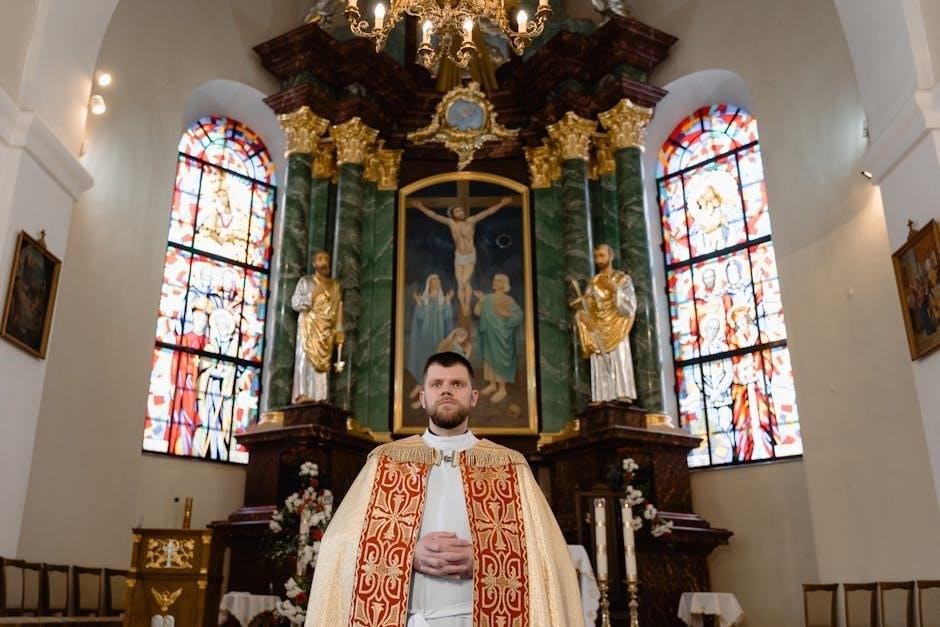
The Eucharistic Liturgy
The Eucharistic Liturgy is the heart of the Funeral Mass, where the bread and wine are consecrated into Christ’s Body and Blood, offering spiritual nourishment and comfort to the mourners.
4.1. Offertory Procession
The Offertory Procession is a solemn ritual where the faithful present the offerings of bread and wine to the altar, symbolizing the sacrifice of Christ. Family members or pallbearers may carry the casket, adorned with a pall, to the altar, accompanied by the priest. This act signifies offering the deceased to God, entrusted to His mercy. The procession is often accompanied by hymns or chants, fostering a spirit of prayer and unity among the mourners; The priest then prepares the altar, placing the offerings on it, and recites prayers invoking blessings and purification. This rite bridges the Liturgy of the Word and the Eucharistic Prayer, deepening the congregation’s participation in the sacred mystery.
4.2. Consecration and Eucharistic Prayer
The Consecration and Eucharistic Prayer are the heart of the Funeral Mass, where the bread and wine are transformed into the Body and Blood of Christ. The priest leads the congregation in prayer, invoking the Holy Spirit to descend upon the offerings. This sacred rite commemorates Christ’s sacrifice and resurrection, offering spiritual nourishment to the faithful. The Eucharistic Prayer includes intercessions for the deceased, asking for their entrance into eternal life. It also expresses hope for the mourners, seeking comfort and strength in their grief. The Consecration and Eucharistic Prayer deepen the community’s union with Christ and reinforce the belief in the resurrection and eternal life.
4.3. Communion Rite
The Communion Rite is a profound moment in the Funeral Mass, where the faithful receive the Eucharist, uniting themselves with Christ and the deceased. The distribution of Holy Communion provides spiritual nourishment and comfort to the mourners. This rite emphasizes the belief in the resurrection and eternal life, as the congregation shares in the Body and Blood of Christ. The Communion Rite also includes the “Prayer of the Faithful,” where intercessions are offered for the deceased, the grieving family, and the entire community. This sacred act strengthens the bond between the living and the deceased, expressing hope in the promise of eternal life through Christ’s sacrifice.

The Concluding Rites
The Concluding Rites bring the Funeral Mass to a reverent close, offering a final blessing and a farewell procession. These rites provide comfort and closure to mourners.
5.1. Final Blessing
The Final Blessing is a solemn moment where the priest invokes God’s grace upon the mourners and the deceased. It is a prayer of comfort and hope, emphasizing trust in God’s mercy. This blessing is typically preceded by a short prayer, followed by the sign of the cross, symbolizing divine protection. The congregation is reminded of Christ’s resurrection, offering solace to those grieving. The blessing concludes the Funeral Mass, preparing the assembly for the recessional and final farewell. It serves as a spiritual sendoff, entrusting the deceased to God’s eternal care while strengthening the faith of those present.
5.2. Recession and Final Farewell

The Recession and Final Farewell mark the conclusion of the Funeral Mass, as the casket is carried out of the church by pallbearers, often family members or close friends. The recessional hymn is sung, offering a final moment of communal prayer and reflection. The procession is led by the cross, followed by the priest, the casket, and the family, symbolizing the church’s accompaniment of the deceased to their final rest. At the church door, the priest may sprinkle the casket with holy water and incense it, signifying purification and respect. This rite serves as a final farewell, expressing hope in the resurrection and eternal life, while comforting the mourners with the assurance of the deceased’s union with God.
